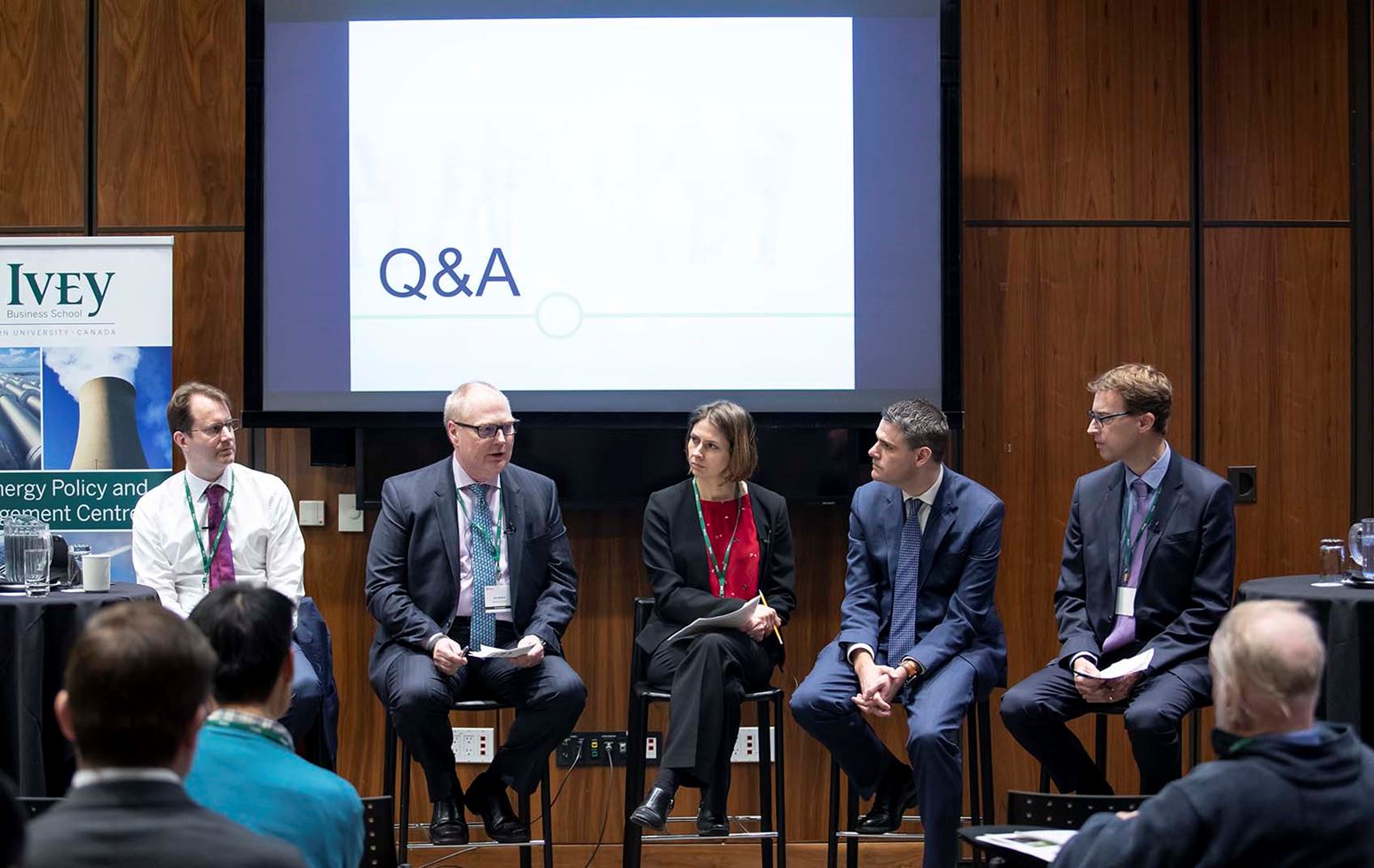Zsolt Vigh is an MBA '19 candidate and President of the MBA Energy Club. He attended an Ivey Idea Forum in Toronto on January 29 called 'Strengthening Trust in the Energy Sector' and blogged about the key takeaways.
“As traditional sources of competitive advantage are eroded, connection with society represents a final frontier of competitiveness, an opportunity to build lasting distinctiveness.”[1]
This powerful conclusion from the book Connect: How Companies Succeed by Engaging Radically with Society formed the basis of discussion at Ivey’s recent Idea Forum in Toronto on January 29. The event focused on strengthening trust in the energy sector and featured a keynote presentation by Robin Nuttall, co-author of Connect and Global Lead of McKinsey’s Regulatory and External Affairs Practice. Nuttall and a panel of energy sector leaders shared firsthand experiences in stewarding connections with their stakeholders and how it led to a meaningful competitive advantage over the long term. Below are some key discussions from the event.
CSR is dead
“And if it isn’t, it should be.”[2] Companies have to rethink how they engage with society. Corporate Social Responsibility (CSR), a tool developed in the 1970s to help address the ongoing tensions between business and society, is an outdated model that has largely failed both companies and society because these initiatives are almost always detached from the core strategic focus of the company. Imagine you removed the company’s brand behind its CSR actions, would you be able to easily identify why they did what they did? Most likely not. In the words of Howard Davies, Chairman of The Royal Bank of Scotland: “In my experience, CSR is seen as largely rather separate from the business, handled by a separate team…Their work is not usually seen as something that relates very closely to what the business actually does. It’s sort of: “We carry out our business and then on Friday afternoon we think about CSR for half an hour.”[3]
In fact, in some cases CSR has been used to compensate for irresponsible behaviour elsewhere in the company. For example, Volkswagen and Enron both received numerous CSR-related awards in the very same year it was revealed they were both defrauding investors and stakeholders alike.
But if companies take up the mantle and make society’s needs part of their business model, they will realize a sustained competitive advantage, on par with that provided by intellectual property.
30/30/30
Research conducted by McKinsey & Company estimates that:
- 30 per cent of corporate earnings are at stake from external decision-making, regulators, and the overall reputation of the company;
- CEOs spend 30 per cent of their time on these external engagement issues; and,
- Fewer than 30 per cent of CEOs feel they are being successful in this field.
As an example, when Volkswagen’s diesel emissions scandal broke, its stock price sank by more than 30 per cent over the subsequent weeks.
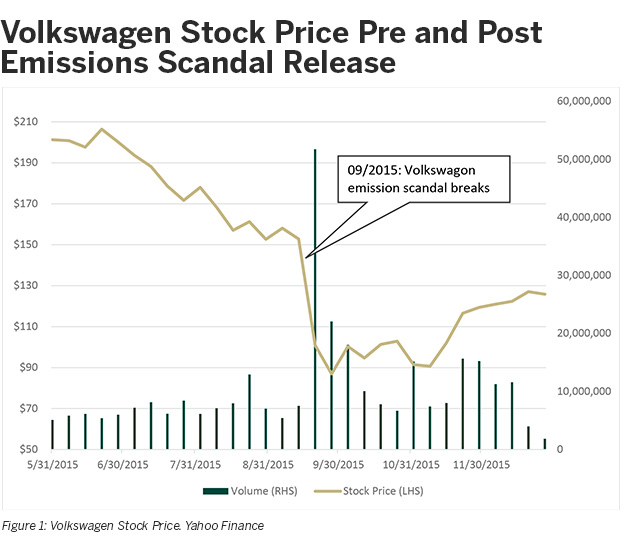
So, with such a large portion of corporate earnings at stake, why have CEOs struggled with effectively engaging with external stakeholders? Again, it all comes back to CSR and how it has traditionally been disconnected from the company’s core business strategy. During the session, Nuttall argued that for companies to fundamentally change direction and succeed in this area, they must radically engage with their stakeholders and make stakeholders’ needs part of their core business strategy.
What’s more is that society is now expecting companies to make society’s needs part of their business model. In a recent Globe and Mail column, Lisa Kimmel, President and CEO of Edelman Canada, argued that Canadians are looking to business and business leaders to act with purpose. The results from the 2019 Edelman Trust Barometer, a global study measuring trust in government, business, NGOs and the media, revealed “Eighty per cent of the general [Canadian] population surveyed trust their employer [… ] and 79 per cent of Canadians – an 11-point increase over last year – believe chief executives should take the lead on change, rather than waiting for government to impose it.” [4]
These findings have been echoed by Larry Fink, Chairman and CEO of BlackRock, the world’s largest asset manager. In his 2018 annual letters to CEOs, he stated: “Society is increasingly turning to the private sector and asking that companies respond to broader societal challenges […] without a sense of purpose, no company, either public or private, can achieve its full potential. It will ultimately lose the licence to operate from key stakeholders.”
The four tenants of connected leadership
So if companies need to radically alter how they approach CSR and embed society’s needs in their business model, how do they go about doing this? From his work with Lord Browne (former CEO of BP), Nuttall pitched a four-step model dubbed “Connected Leadership,” that if vigorously applied would fundamentally alter a company’s relationship with its stakeholders and yield a sustained competitive advantage.
Map your world
- Executives need to:
a. Rigorously map out all their stakeholders;
b. Quantify the economic impact that their decisions will have on them; and,
c. Quantify the corporate value at stake from external issues related to decisions taken by stakeholders. - These metrics need to be distinguished between short-term and long-term horizons.
- Secular trends affecting the business need to be separated from fads.
Despite the massive value at stake, only 50 per cent of executives surveyed had even quantified the impact of their decisions on stakeholders or what the value at stake was for their company.
A major advantage of this mapping exercise is being able to spot issues early where the resources required to solve them are much more manageable. Anyone from the energy industry looking at the graph below will instantly draw parallels to the ongoing struggles that the energy industry has faced in getting its story out after waiting for years before it started to meaningfully engage with the public.
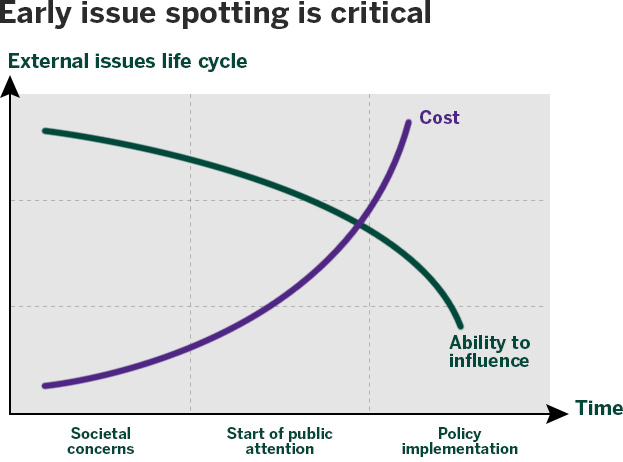
Define your contribution
From McKinsey Global Institute’s Ranking of the top social burdens (see below), to the European Union’s 17 sustainable development goals, companies need to clearly articulate how their core business ties in with helping to advance society’s needs and solve its problems.
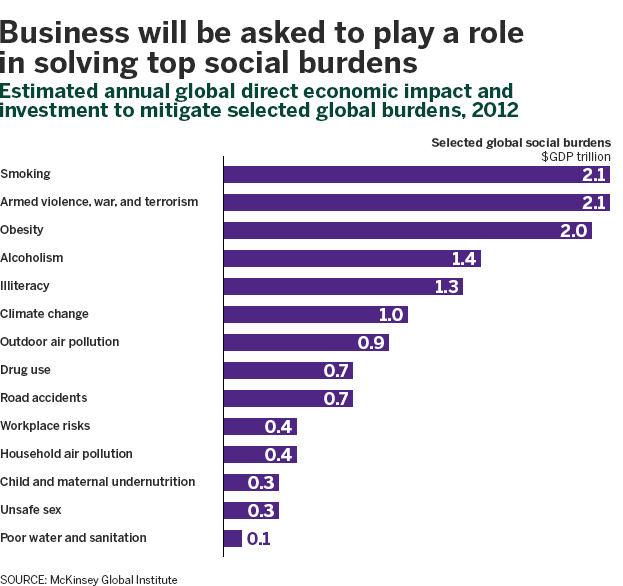
Rio Tinto, a global mining giant, underwent this four-step process and has completely transformed how it conducts business. The company has stated it will “pursue profits with performance” and has placed community engagement and proactive reporting at the highest levels of the company in terms of importance.
In short, how you act as a corporation in society will determine whether you “win the game” or simply “play it.” Which CEO only wants to play?
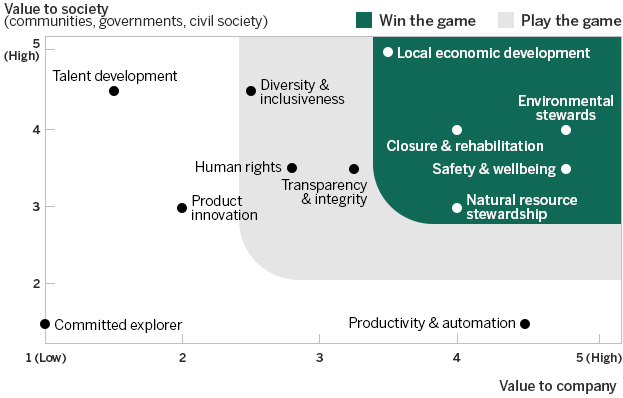
Embed in the line
How do you ensure these new social metrics appear in the core business model of a company? You embed them in the scorecards of CEOs. Without developing a proper incentive structure, these metrics would devolve to another CSR initiative and simply not move the needle. Yet only 16 per cent of executives surveyed had quantified the social and financial impact of their activity.[5] This appears to be changing. In the energy world, Royal Dutch Shell announced in December 2018 that it will “Link Carbon Emissions Targets to Executive Pay” and in February 2019, [6] Chevron tied executive pay to methane and flaring reduction targets.[7] Companies that can do this will seize a major source of competitive advantage over their peers.
Engage radically
Here corporations must radically engage with stakeholders and involve them in the decision-making from the onset. Doing so will not only lower your project-related risk, but it may also represent tremendous upside for your corporation as well.
Eric Axford, Executive Vice-President and Chief Sustainability Officer for Suncor Energy, provided a masterclass example of how this is done. In November 2017, Suncor and the Mikisew Cree and Fort McKay First Nation signed a joint-venture agreement where the two First Nations purchased a 49-per-cent equity stake in a major oil sands project. This investment will provide a steady stream of revenue to these First Nations for the next 25 years. [8] In the words of Eric Axford: “This completely transformed our relationship where we are now co-partners in a project with common long-term objectives.”
Bonnie Hiltz, Director of Power and Utilities at the Sussex Energy Group, advised that deeply engaging with the public should be part of your corporate strategy. She argued the public has greater access to information than ever before, and as such expects more from companies than in the past.
But who do corporations use to best send their message?
Employees! Your fellow employees are the strongest source for building grassroots support for your industry and can act as major ambassadors if they are motivated by your cause. Technical and academic experts also ranked high in the 2018 Edelman Trust Barometer survey and should be leveraged to help build trust in your industry.
Lastly, don’t be afraid to tell your story. James Scongack, EMBA '17, Executive Vice-President of Corporate Affairs and Operational Services for Bruce Power, discussed how local communities can be important supporters of energy development given the economic development and job creation benefits.
Closing thoughts
As we all know and appreciate, business is one of the greatest engines of human progress. But tensions between private enterprise and society have at times impeded growth and development in certain industries, as we have seen in the energy sector of late. To break this impasse, companies must radically engage with society, and visibly demonstrate they are incorporating society’s needs into their core business model. Energy companies such as Suncor and Shell have shown that this can happen. To move past this impasse, other companies in the sector must do the same.
[1] Browne, J., Nuttall, R., & Stadlen, T. (2016). Connect: How companies succeed by engaging radically with society. London: WH Allen.
[2] Ibid.
[3] Ibid.
[4] Canada's unprecedented trust gap: Who will build the bridge for a country divided? (2019, February 14). Retrieved from https://www.theglobeandmail.com/business/commentary/article-canadas-unprecedented-trust-gap-who-will-build-the-bridge-for-a/.
[5] Browne, J., Nuttall, R., & Stadlen, T. (2016). Connect: How companies succeed by engaging radically with society. London: WH Allen.
[6] Kent, S. (2018, December 03). Shell to Link Carbon Emissions Targets to Executive Pay. Retrieved from https://www.wsj.com/articles/shell-to-link-carbon-emissions-targets-to-executives-pay-1543843441
[7] Hiller, J. (2019, February 07). Chevron ties executive pay to methane and flaring reduction targets. Retrieved from https://af.reuters.com/article/energyOilNews/idAFL1N2011IQ
[8] Onoszko, M., & Bloomberg News. (2017, December 06). First Nations bond deal breaks ground for Indigenous Canadians, sets stage for future business partnerships. Retrieved from https://business.financialpost.com/news/fp-street/first-nations-bond-deal-breaks-ground-for-indigenous-canadians
